Editor’s Note, 4/29/20: This article was originally published on October 28, 2019. We want to ensure you have the most up-to-date information about popular decks, so we’ve updated this article and re-published it on April 29, 2020.
Editor’s Note, 8/3/20: Cauldron Familiar has been banned in Standard effective August 3, 2020. Read the full announcement from Wizards of the Coast here.
Sacrifice Aggro (or “Aristocrats”) is one of those historically cool archetypes of Standard. Almost every set has some sort of card that makes people excited that the deck is coming back! The reality doesn’t always live up to the hype, but signature rare Priest of Forgotten Gods and friends have been able to do some serious work since Ravnica Allegiance.
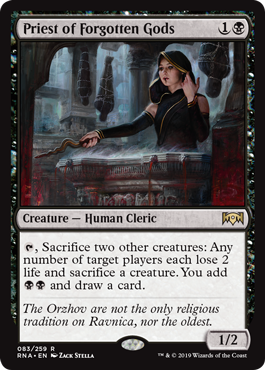
The Priest’s supporting cast has changed a few times since then – first to incorporate the unusual cat-oven combo from Throne of Eldraine, and now adding the mighty companions from Ikoria: Lair of Behemoths! I’ve updated this primer to reflect the new game plan and deck-building options available in Ikoria Standard, and I hope it’ll help you and your chosen sideboard pet make the run to Mythic.
THIS MACHINE KILLS ONE-DROPS
Aristocrats decks have a hybrid game plan, falling somewhere between traditional creature aggro and a creature-combo or “engine” play style. Current Standard decks are too good at getting value and ramping for traditional aggro to be worthwhile, so all present builds of Aristocrats focus heavily on building their own engine. This means stacking cards like Mayhem Devil and Midnight Reaper — which give us useful triggers when our creatures die or are sacrificed — then using the abilities of Woe Strider, Witch’s Oven and Priest of Forgotten Gods to make those sacrifices happen.
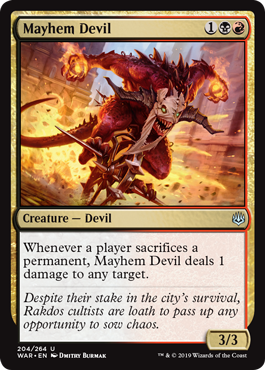
Accepting our role as an engine deck creates some important differences in how we play and build Aristocrats. Firstly, we don’t really care about combat anymore. We’ll certainly chip in a bit of damage when it’s free, but our creature selection is focused on what is most valuable to keep the sacrifices flowing. A few sets ago when this deck was all about Judith, the Scourge Diva, we played Gutterbones and Knight of the Ebon Legion as Standard’s most aggressive one-drops. Now, we play Whisper Squad and Serrated Scorpion.
This deck-building shift should be accompanied by more defensive and passive play in-game. Our creatures in play are the currency we trade for wins; even our pathetic one-drops are precious fuel for the Witch’s Oven. If we have four attackers to their one blocker, I would still seriously consider making no attack; the three-ish damage might not be worth losing a sacrifice down the line.
This also means we should avoid chump-blocking unless we have to — despite that usually being the best use for a card like Serrated Scorpion. Of course, once our sacrifice engine is online, it becomes trivial to chump all non-evasive attackers by sacrificing after blocks are assigned! Ironically, it’s this casual blanking of attack steps combined with the battlefield control of Mayhem Devil which helped drive non-Embercleave aggro decks out of the format.
HOLD UP – CAT OVEN?

Cauldron Familiar is the latest in a long line of otherwise-underwhelming one- and two-mana creatures played in Aristocrats. However, with one or more Witch’s Ovens in play, it becomes a sticky blocker that threatens to drain opponents to death! The more Ovens you have in play, the more triggers you can squeeze out of Mayhem Devil and friends. This combo has become the foundation of our deck, and it’s hard to imagine an Aristocrats build not including it.
PICK YOUR POKEMON
One might think that, if Aristocrats solely focuses on engine builds, there would be a smaller range of deck-building choices. But thanks to Ikoria, we now have an even more fundamental question to consider: which companion to build around!
While the hype around Ikoria focused heavily on the mutate mechanic, the cycle of ten legendary companion creatures has completely dominated discussion since. The benefit of an extra card “in hand” for every game — and a powerful one at that — seems like a fantastic deal for the cost of a sideboard slot and an often-incidental limit on deck-building. Every new deck build now begins with asking which companion you’re aiming to build around, and Aristocrats is no exception.
Our three viable options are Lurrus of the Dream-Den, Jegantha, the Wellspring, and Obosh, the Preypiercer. Each leads you to one or more distinct builds of Aristocrats and will significantly affect your card choices.
LURRUS, I CHOOSE YOU!
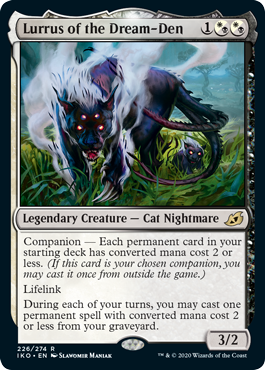
Lurrus of the Dream-Den is perhaps the most powerful and controversial of the companions across all constructed formats. It’s slightly weaker in Standard since the average CMC of key spells is higher, so the deck-building restriction is actually restrictive. Aristocrats loses access to its most powerful pay-off cards, the ones which usually push our engine over the top: Mayhem Devil, Judith, the Scourge Diva, Midnight Reaper and Bastion of Remembrance.
That is a hefty price, but in return, Lurrus solves the biggest weakness of engine decks: their vulnerability to removal. We count on occupying the board with several fragile creatures at the same time, and just two or three pieces of spot removal in the early game can completely wreck our day. Lurrus buying back a key card like Priest, Oven or Cruel Celebrant makes our weak draws reliable and our best draws unbeatable. Lurrus decks can be RB, but also WB or Mardu.
OBOSH, I CHOOSE YOU!
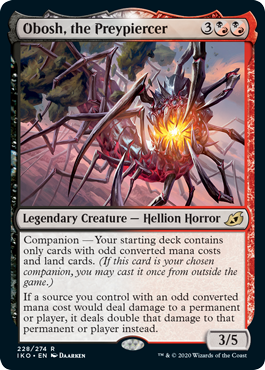
Obosh, the Preypiercer is a little expensive compared to our curve but is the perfect card for longer games where we do try to go over the top, massively improving the power of our engine and even giving us a look at combat. The loss of even-CMC cards really only costs us Priest from the core suite, so this companion is actually less restrictive than Lurrus! Many Obosh lists also play Lurrus in the main, so it’s possible to have the best of both worlds.
Obosh builds have picked up a ton of momentum this weekend and even won large online tournaments, which shows how good Mayhem Devil is in the current meta! This variant also benefits from getting a bit of aggro power back, running Judith and Heraldic Banner as pump effects which then get even more value out of Obosh. Obosh builds thus far are straight RB, although I see no reason why they couldn’t move to Jund soon.
JEGANTHA, I CHOOSE YOU!
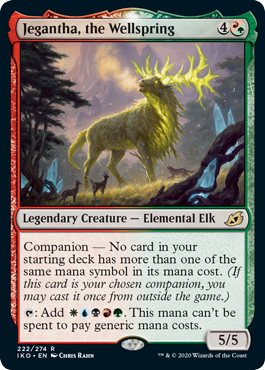
Let’s be honest, this one should really say “Korvold, I choose you!”
Jegantha is not the most thrilling of companions, but it is very easy to meet the requirements and it’s still a “free” 5/5 with relevant text. Its ability does make it slightly easier to justify a third color, and it doesn’t take long to remember why Jund Sacrifice emerged as the most powerful cat-oven deck in Eldraine Standard. Korvold, Fae-Cursed King is busted, busted, busted!
Once you get the hang of preparing for your King’s arrival — producing extra food, leaving spare Fabled Passages in play, etc. — he should always resolve as a giant flier which draws three to five cards. Korvold is by far the single most powerful card any Aristocrats deck can play, on par with anything else in Standard. Having access to such a haymaker is very tempting, and green also offers key tools like Gemrazer and Gilded Goose. Jegantha decks have so far been Jund for this reason.
DEVIL MAKE CRY
So, the game plan is set: Play cheap creatures and attack when we can while setting up our Priest or cat-oven engines, then whittle their remaining life away. I’ll quickly evaluate some of the available card choices, noting considerations for each build.
ONE-DROPS
We need 8-12 to start getting on the board ASAP.
Cauldron Familiar
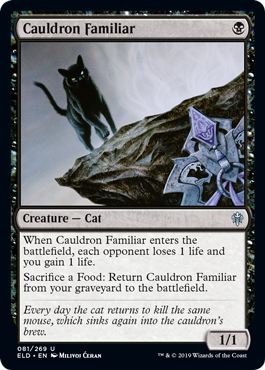
One of the few commons in history which can rightly claim to have created a Standard archetype. Awful card without an Oven to combo with, but all creatures are the same when choosing a sacrifice! I used to go down to three copies, since you only need one cat to combo, but the deck is so focused on this now that four seems mandatory.
Whisper Squad
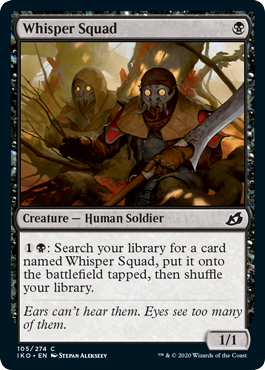
We want to put as many creatures into play as we can, and this is the rare one-drop which brings more than one body to the table. It’s also a nontoken body, which is good for Judith, Obosh, and Midnight Reaper, as well as ultimately putting more cards in graveyard for escape! While it may cost mana, you’re “saving a card” over playing a one-drop from hand. It also gives you a guaranteed outlet for the mana Priest generates — or for your turn two mana in an Obosh build.
Serrated Scorpion
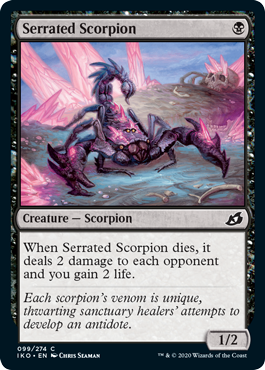
Whether this card is really better than the aggressive options like Gutterbones and Knight of the Ebon Legion remains to be seen, but so far, it has been a popular choice. It mostly shines in Lurrus builds, where the ability to recur it makes it seem like a better Cauldron Familiar in some games.
Gutterbones
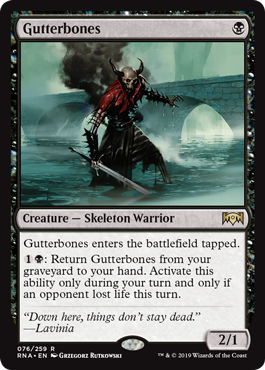
Previously the strongest one-drop, it’s now lost its place in many builds. I would guess that the 2/1 statline no longer seems as relevant, and the recursion ability is too expensive compared to other options. It’s fantastic in Obosh, though, where you need extra one-drops and can actually look to push combat damage. Possibly slept on for other builds.
Footlight Fiend
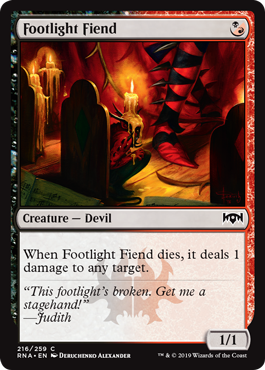
This card could be taken as a replacement for Serrated Scorpion in Lurrus builds. The point of directed damage can snipe a creature or Planeswalker after combat more often than you’d think, and Call of the Death-Dweller can return it to play with deathtouch, which is amazing.
Stonecoil Serpent

Not many players consider this one, but it’s a great fit. It’s a one-drop when you need it, and immune to common problems like Teferi and Deafening Clarion. But it can also scale with available mana, giving us a big late-game threat even in Lurrus builds! And in control match-ups where our main-deck Claim the Firstborn lacks targets, you can use them to give a 4/4 or 5/5 Serpent haste for a surprise attack! You can also recur it with Lurrus, though only as a 2/2.
Alseid of Life’s Bounty
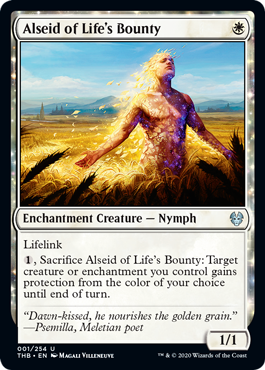
A special include for the WBx Lurrus decks, but a very nasty one. This drives home the resilience of the Lurrus plan, allowing you to continuously sac it to protect valuable cards like Priest or Lurrus itself.
TWO- AND THREE-DROPS
For just a bit more mana, we’re getting creatures which actively add value to our engine, or at least generate multiple bodies to feed it efficiently.
Priest of Forgotten Gods

The ultimate feast-or-famine card. 50% of the time, your opponents will deal with this card before you get to untap with it. 20% of the time, it will sit alone on the board and feel terrible. 30% of the time, it will force the opponent to concede. This card thrives in creature-dominated metagames; it was dormant during the Oko times, but now it’s back to must-answer status against nearly every deck! Obosh can’t play her, but she’s otherwise a staple.
Kroxa, Titan of Death’s Hunger
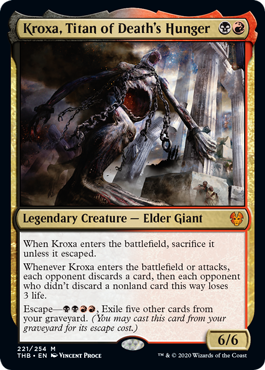
Mostly Lurrus-exclusive tech, although the potential to escape a 6/6 gives the deck a “free” top end it otherwise lacks. Lurrus can theoretically loop this every turn to punish opponents who try to hold cards.
Dreadhorde Butcher

A card which has never quite impressed me, but which has finally begun showing up in winning Lurrus lists. At its best against Fires and other decks which start slow, or when you can give it extra power or deathtouch. Keep in mind that if it dies to -X/-X effects or is exiled, you will not get to ping anything, so it’s often correct to hold up a sac outlet to “save” it.
Cruel Celebrant
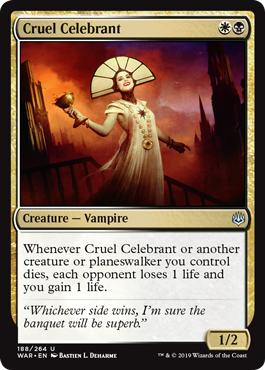
A Mayhem Devil replacement for WB Lurrus builds, sort of, if you squint. Never has quite the same game-winning potential due to not sniping creatures or triggering from food or your opponent, but gets the job done under Lurrus restrictions and opens up the options to include Ajani’s Pridemate.
Midnight Reaper

This has a decent body (especially on the defensive) and performs the extremely valuable task of helping us weather the effects of sweepers. We’re forced to commit multiple creatures to the board in order for our game plan to work, so the ability to refill our hand when our creatures die is crucial.
Mayhem Devil
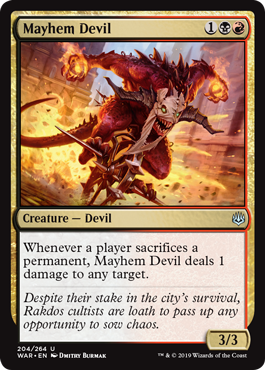
Outside of our sacrifice outlets, this is our most essential engine card. Adds value to cat-oven, Priest, Chandra, and Woe Strider. Being able to target the damage means this immediately locks down the board if you have cat-oven. Triggering for both players means it DESTROYS the mirror, and is worth mulliganing for in that match. Having to lose Mayhem Devil is the biggest barrier to success for Lurrus decks.
Judith, the Scourge Diva
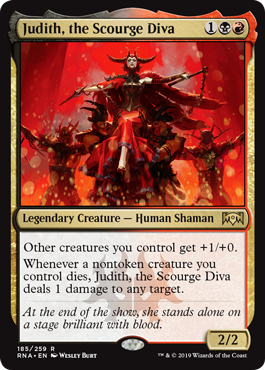
In aggressive builds, this does more work than Mayhem Devil, but the spotlight drifted away from this Diva when we went full engine. The ping effect is not as potent as Devil’s, since it won’t trigger from food, lands, or your opponents’ stuff. It’s still close to an extra copy of our best card, but the three-drop slot is very crowded (and nonexistent in Lurrus), so she’s only a fringe choice for Obosh.
Chandra, Acolyte of Flame
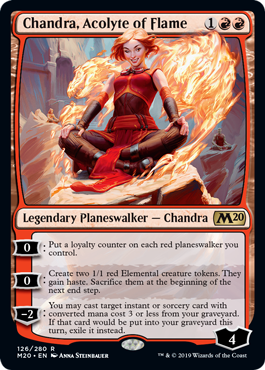
Decent alone if not pressured; amazing in combination with Priest, Oven, Devil, or Judith. Main considerations are double-red cost and how bad we are at protecting her with blockers, but having spells for her -2 also matters. Might be useful if we go back to main-deck burn/discard.
NONCREATURE SPELLS
Noncreature spells don’t directly support our main plan of sacrificing creatures, but it can be good to have a few in your deck. These spells are always good to have in your sideboard, but try not to swap out too many creatures for them. I would advise a minimum of 26 creatures or token-creators at 3 CMC or lower for this archetype.
Witch’s Oven
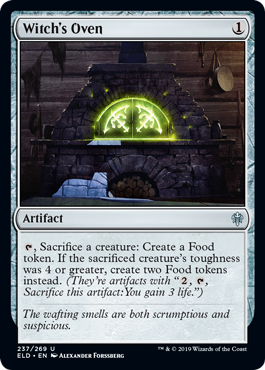
A key engine piece for this deck. Largely useless by itself, but great with Devil, Reaper, and, of course, the Familiar. The art of when to activate this and what to sacrifice is one of the more subtly skill-intensive parts of the deck. It can be very important to save cards from exiling removal or to fizzle Bonecrusher Giant and Brazen Borrower adventures.
Drill Bit

This is more palatable to main-deck than Duress, and hitting Hydroid Krasis is important in this meta. Since cat-oven builds consist of very small creatures and can take a while to win, taking out big threats like Questing Beast can sometimes be as important as discarding a sweeper.
Claim the Firstborn
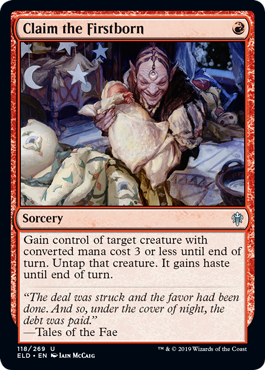
Taking the two- or three-drop from an aggro deck, hitting them with it, then sacrificing it is a game-winning play and justifies having some number of these in the main deck. At worst, you can target your own creature to untap it and grant haste. Otherwise, hold onto them till you have a sacrifice outlet, like Priest or Oven, so you can dispose of their creature.
Dead Weight/Mire’s Grasp
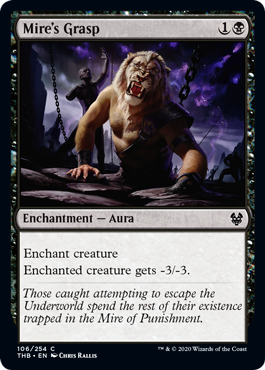
These are extremely powerful tech for Lurrus builds, offering you endless spot removal in a meta dominated by value creatures trying to sit around unnoticed.
Call of the Death–Dweller
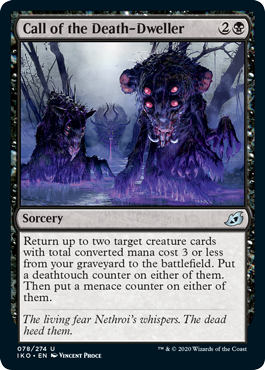
A staple of every successful Lurrus build, this can either bring back Lurrus to continue the value train, or resurrect two bodies for an immediate Priest activation. You can put both the ability counters on the same creature even if you reanimate two, which is very good with Dreadhorde Butcher.
A FINAL WARNING
One thing you definitely need to consider before picking up any Aristocrats list — especially Lurrus builds — is how to handle Grafdigger’s Cage.
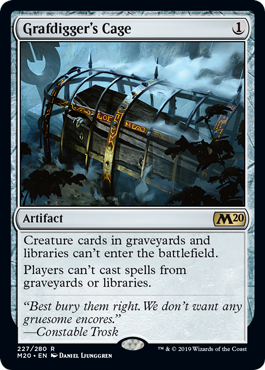
This sideboard card goes in any deck, costs one, and invalidates your entire strategy. It’s a counter for both Aristocrats and the Gyruda combo list, as well as any other Lurrus deck, so it’s commonly played in high numbers. Some decks are even able to play it game one thanks to Karn, Great Creator or Fae of Wishes. RB decks need Bedevil and Embereth Shieldbreaker, WB decks need Heliod’s Intervention, and Jund decks need Gemrazer or Thrashing Brontodon. The fact that the green options are respectable main deck choices is one of the main advantages of Jund.
Speaking of Jund, I’ve got an inkling that the ultimate direction of this archetype will be Jund Obosh. Combining the strongest companion with the strongest bomb (Korvold) and strongest anti-hate plan only costs us Priest from the current Jund decks, and Gilded Goose helps cover awkward gaps in the curve that Obosh creates. If you’re interested, I’ll be showing off my lists both on Twitch and Twitter.
Stay safe, and happy saccing!

Tom’s fate was sealed in 7th grade when his friend lent him a pile of commons to play Magic. He quickly picked up Boros and Orzhov decks in Ravnica block and has remained a staunch white magician ever since. A fan of all Constructed formats, he enjoys studying the history of the tournament meta. He specializes in midrange decks, especially Death & Taxes and Martyr Proc. One day, he swears he will win an MCQ with Evershrike. Ask him how at @AWanderingBard, or watch him stream Magic at twitch.tv/TheWanderingBard.

